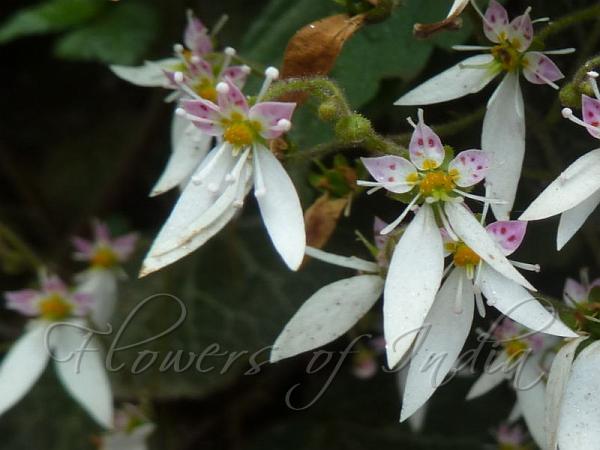|
| Strawberry Begonia |
|

|

| File size | 108253 |
| Original date | 6/2/16 1:53 PM |
| Resolution | 800 x 600 |
| Flash | Flash did not fire, auto |
| Focal length | 4.1mm |
| Exposure time | 1/60s |
| Aperture | 3.3 |
| Focus Distance | |
| Metering Mode | Multi-segment |
| Camera make | Panasonic |
| Camera model | DMC-TZ10 |
| Sensor type | OneChipColorArea |
|
|
|
|
Photo: |
Botanical name: Saxifraga stolonifera Family: Saxifragaceae (Saxifrage family)
Synonyms: Saxifraga chinensis, Saxifraga ligulata
Synonyms: Saxifraga chinensis, Saxifraga ligulata
Strawberry Begonia is a perennial herb 8-45 cm
tall, but is not really a begonia. Flowers are borne in 7-61-flowered
clusters. Sepals are spreading to curled back, ovate, 1.5-3.5 x 1-1.8
mm. Petals are 5, white, spotted, of which largest two are
lanceshaped-oblong, 0.6-1.5 cm x 2-4 mm, base clawed, tip pointed,
pinniveined; smallest three petals are ovate, 2-4.4 x 1.3-2 mm. Stamens
4-5.2 mm. Stolons are thread-like, densely crisped glandular hairy,
with scaly leaves, stem glandular hairy. Basal leaves has leaf-stalk
15-21 cm, glandular piliferous. Leaf blade is spotted, somewhat
heart-shaped or kidney-shaped to round, 1.5-7.5 x 2-12 cm, 7-11-lobed,
glandular hairy, base somewhat flat or rounded to heart-shaped, margin
irregularly toothed, tip blunt or pointed. Stem leaves and bracts 1-4,
lanceshaped, about 6 × 2 mm. Strawberry Begonia is native to East Himalaya,
China, Japan, South Korea, cultivated in hill-stations of India.
Flowering: April-November.
Medicinal uses: Strawberry Begonia is
considered to be antibacterial, antiphlogistic. There are
growth-promoting substances in the leaves. The whole plant is
depurative, febrifuge and suppurative. Its use promotes the drainage of
pus. A decoction is used in the treatment of boils and abscesses,
poisonous snakebites, otitis media, acute attacks of convulsions and
haematemesis. The leaf juice is applied to aching ears, abscesses and
inflammations.
Strawberry Begonia is
considered to be antibacterial, antiphlogistic. There are
growth-promoting substances in the leaves. The whole plant is
depurative, febrifuge and suppurative. Its use promotes the drainage of
pus. A decoction is used in the treatment of boils and abscesses,
poisonous snakebites, otitis media, acute attacks of convulsions and
haematemesis. The leaf juice is applied to aching ears, abscesses and
inflammations.
Medicinal uses:
 Strawberry Begonia is
considered to be antibacterial, antiphlogistic. There are
growth-promoting substances in the leaves. The whole plant is
depurative, febrifuge and suppurative. Its use promotes the drainage of
pus. A decoction is used in the treatment of boils and abscesses,
poisonous snakebites, otitis media, acute attacks of convulsions and
haematemesis. The leaf juice is applied to aching ears, abscesses and
inflammations.
Strawberry Begonia is
considered to be antibacterial, antiphlogistic. There are
growth-promoting substances in the leaves. The whole plant is
depurative, febrifuge and suppurative. Its use promotes the drainage of
pus. A decoction is used in the treatment of boils and abscesses,
poisonous snakebites, otitis media, acute attacks of convulsions and
haematemesis. The leaf juice is applied to aching ears, abscesses and
inflammations. | Identification credit: Umberto Boni | Photographed in Darjeeling & Delhi. |
• Is this flower misidentified? If yes,